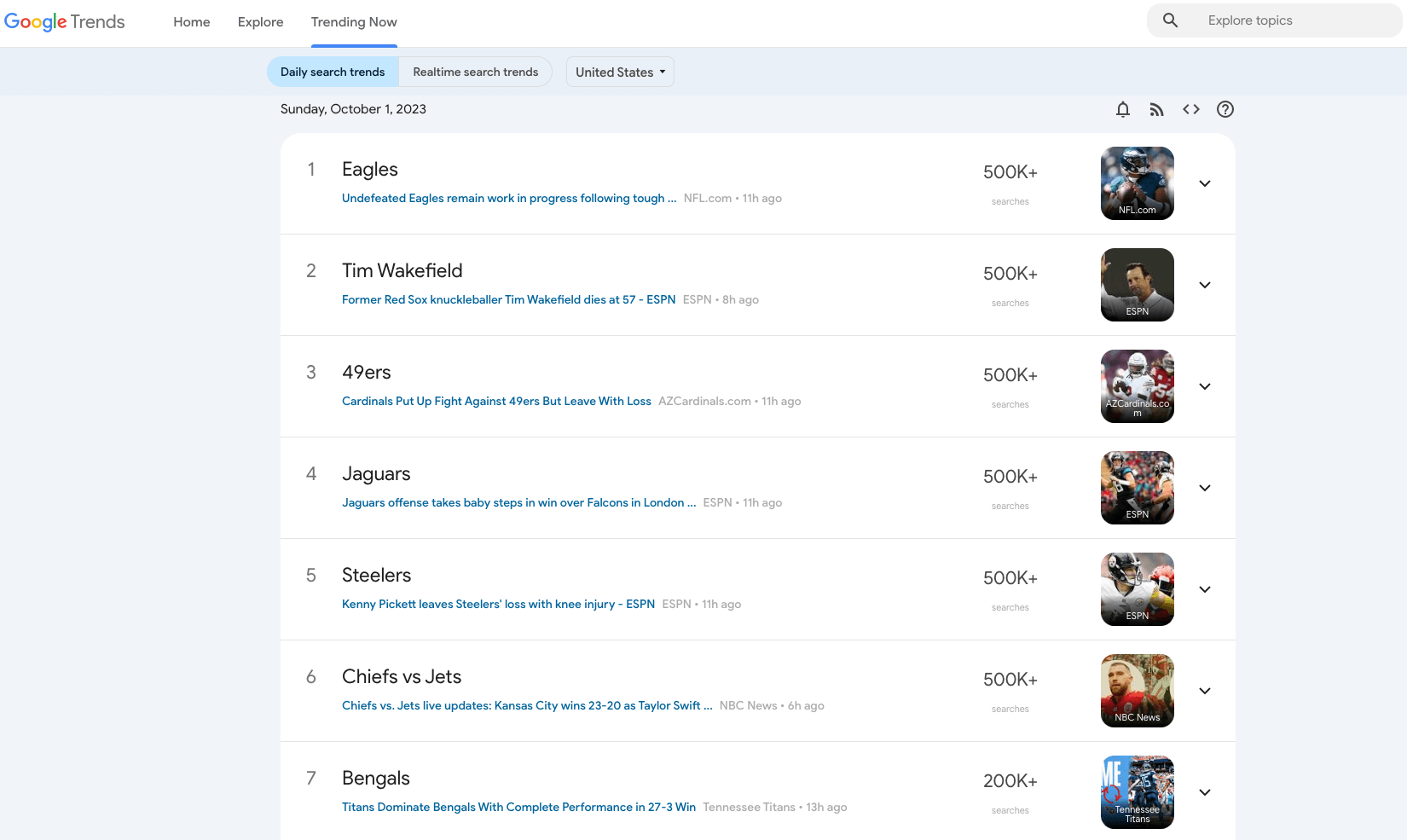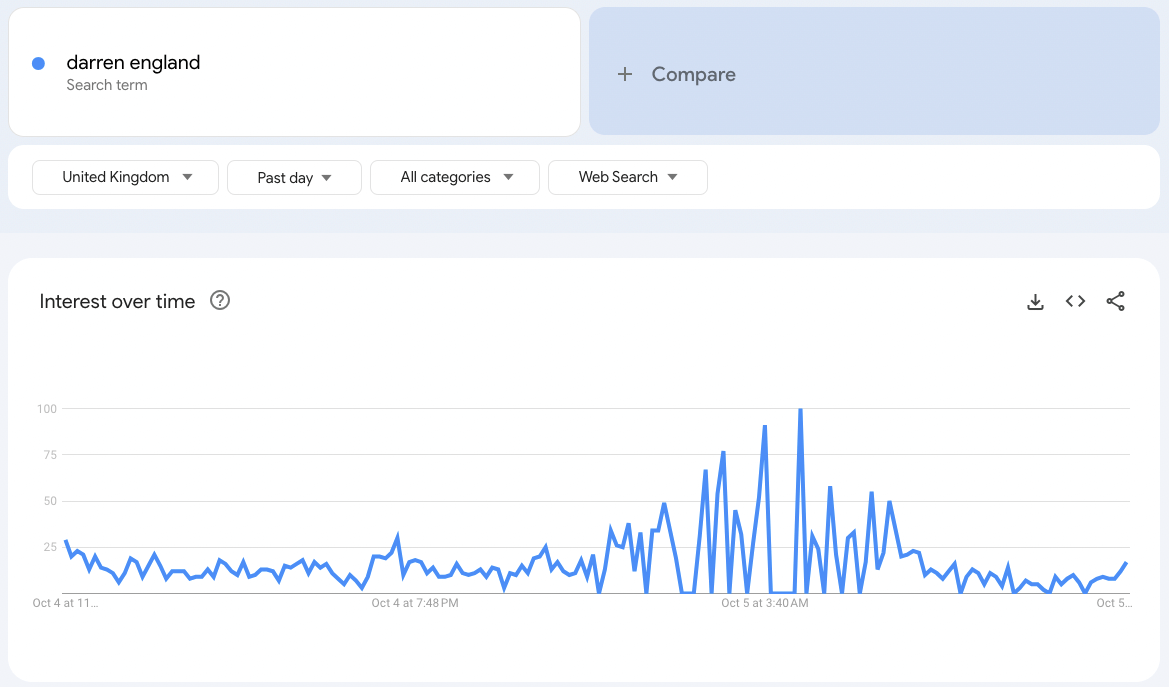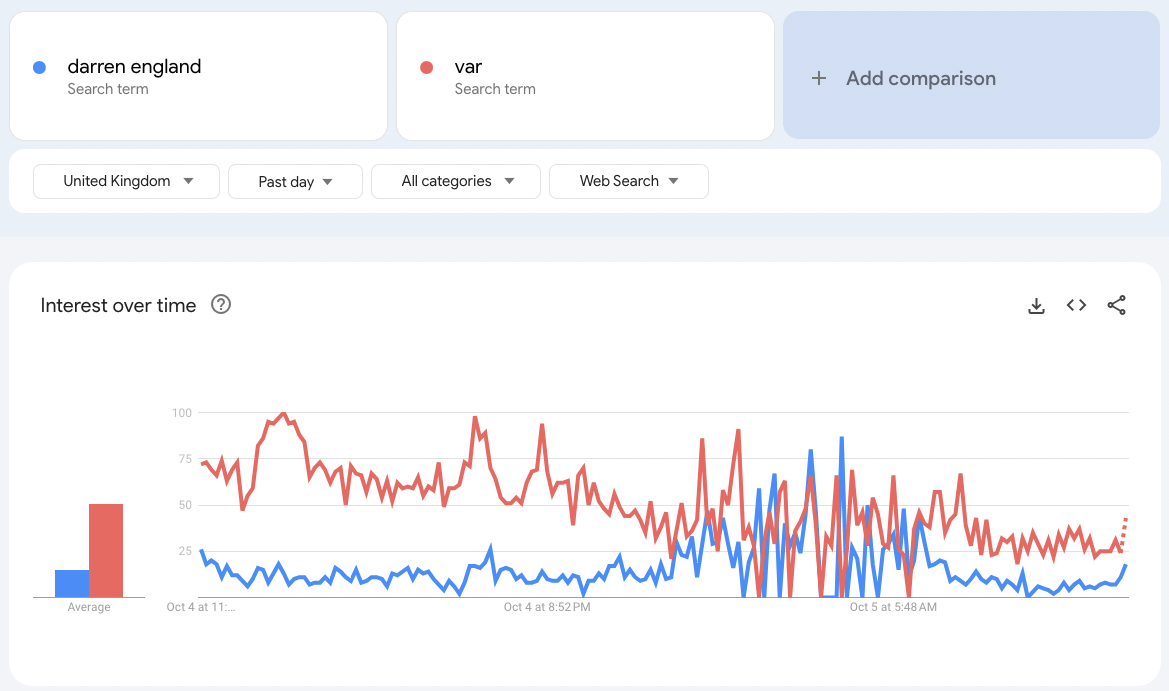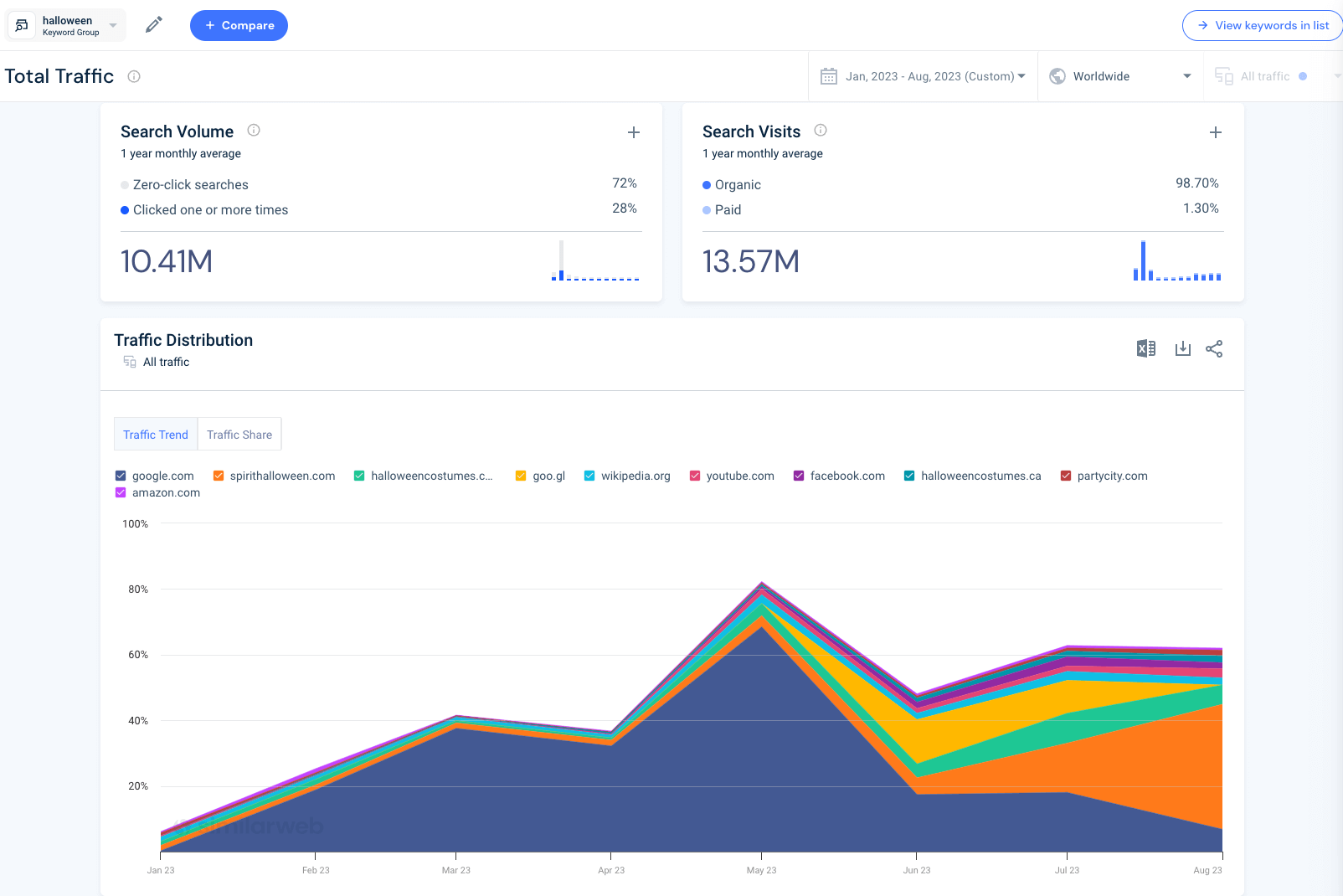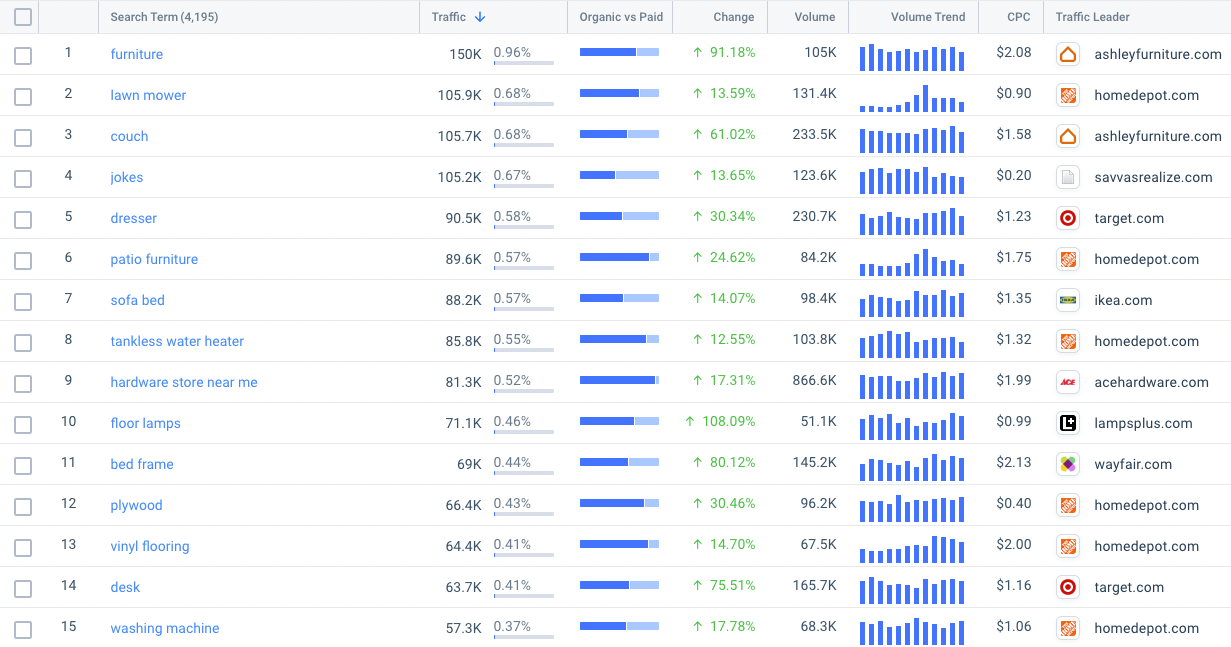Similarweb Trends vs Google Trends: Who Does It Best?

Staying on top of the trends isn’t just about being or sounding cool in front of your pals (but it helps) – it helps you to market your product in the most relatable and efficient way for your target audience.
It’s often easy to spot the newest trends once they’ve gotten big, but how do you catch them as they are growing and before the trend has passed?
We’re here to talk you through the difference between Similarweb Trends and Google Trends, and how each of them can help you ride the marketing wave of trending topics.
What’s the difference between Google Trends and Similarweb?
Google Trends is a free tool that reveals the most popular search terms seen on Google search, including Google image search, news search and shopping, but also YouTube search.
Similarweb is a comprehensive data platform that provides marketing teams with all the insights and numbers – including for trending keywords and topics – that they need to win in the ever-competitive world of search, whatever their industry or business-size.
The difference? Raw data. Similarweb uses its real-time, real-user data to provide fresh and up-to-date information that can inform any marketing strategy with the cold, hard numbers. Whereas Google’s metrics are far more relative to a search term’s popularity out of 100, or what it’s being directly compared to.
Google Trends vs Similarweb Trends
Google Trends
Let’s look into the pros and cons of using Google Trends as a marketing tool:
✅ It’s free
Who doesn’t love a freebie? This makes Google Trends widely accessible to anyone that uses the internet, meaning you can see the most talked-about topics around the world or in your country at the click of a button.
✅ Quick comparisons
Google Trends is an easy-to-use platform that allows you to compare between search terms easily, giving you a good idea how popular some terms are versus others. Its Trending Now gives you the hottest keywords in daily search and real-time search (which is especially great if you love to keep up with news and sport).
❌ It’s based on popular search terms
But there’s a downside to popular search terms. If you love football, you can guarantee Google Trends’ trending page is filled to the brim with top articles about the recent NFL games on a Sunday night or Monday morning. This is a page that becomes quite exclusive, and (most likely) irrelevant to your business – the same goes for the suggested Search topics and Search queries on the Explore page. Which leads us on to our next point…
❌ Manual keyword research process for your business’ keywords
With a focus on international or national popular search terms, Google Trends makes it difficult for you to find business-related trending keywords. While you can add and compare your own search terms in the blank box, the process is manual and based on guesswork or external sources of keyword research, as it provides no insight into growing keywords in your specific industry.
❌ Unclear and unmeasurable metrics in a business capacity
If you know the keywords you’re looking into, you are given a graph of the keyword’s traffic trend over time. However, this is based on a scale of 0 (when there was no traffic) to 100 (when it hit its peak in traffic). Working in marketing, you’ll know that peaks can increase – and you’ll want them to increase. Not only that, but this makes keywords incomparable to other keywords as it doesn’t provide the absolute numbers.
Here we have an example of two trending search terms that individually had reached their ‘peak’ of 100, but in comparison (below image), their Google Trends metrics are very different.
❌ Not for marketing teams
Marketing teams need a data-driven strategy to succeed on search. WIthout the data, it becomes guesswork, and that results in poor planning and poor results. Trending topics and trending keywords are both things that need to be considered in a marketing strategy to resonate and stay relevant, and without the facts and stats, you’ll fall behind quickly. Google Trends is great to use in conjunction with other reliable data-providers or for more personal use.
Similarweb Trends
And here are the pros and cons of using Similarweb and it’s trend-finding tool for your marketing strategy:
❌ Okay, so it’s not free
They say money can’t buy you happiness, but from as little as $125, it can buy you the freshest data on the market, along with a complete toolkit to help you crush it on search, and say a final farewell to all those competitors of yours.
✅ Freshest (and most all-inclusive) data on the market
With real-time, real-user data, you gain access to trending keywords and topics as they happen. And Similarweb doesn’t stop at popular terms – if you want to dive deeper into the top trending keywords around football you can, but if you want to dive deeper into more business-critical (or business-curious) terms, it’s got you covered.
Track the performance of entire Keyword Groups, like this view of a custom “halloween” related keyword list.
✅ No guesswork, just data
Similarweb provides all the performance and engagement metrics you need to make accurate and data-driven decisions, win keywords, win traffic, and outperform your competitors. See the raw data for traffic numbers, engagement rates, keyword search volume, search volume for customizable keyword groups, keyword difficulty, and more.
✅ Keywords by Industry
See new or returning trending keywords that are related to your business in Similarweb’s Keyword by Industry module. Here, you can spot trending topics and ‘newly discovered’ searches within a certain date range, or make the most of the Last 28 Day view for ultra fresh keyword data. On top of that, you can customize your industry (because we all know it’s not always a one-size-fits-all) and look into keyword seasonality.
Here we have the Home and Garden industry trending keywords right now, based on US traffic.
✅ A holistic approach to search
The Trending Now page on Google Trends is all well and good, but with Similarweb you get a beginning to end view of the top keywords used to get to the leading website, the other top leading websites, and other marketing channels that got them there. Search is more complicated than ever, but Similarweb provides a full view of what’s happening by understanding different traffic sources, including paid versus organic links.
The results are in
While Google Trends is free, it is limited for anything beyond personal use.
Trending topics and keywords are based on popular terms, compared to Similarweb’s more inclusive metric of increase in search volume. This is why news events and sports can be a little all-consuming in terms of topics when you land on Google Trends, meaning you won’t necessarily find any link to your business.
Similarweb allows you to search for trending keywords and trending topics that are specifically (or more distantly) relevant to your industry, business, and target audience. It provides you with search terms that have different keyword difficulty, to give you a realistic and achievable way to win more traffic.
But not only that. Similarweb provides the numbers you need to make real data-driven decisions, from traffic and search volume, to rankings and PPC spends.
The better the data and the more informed your decision-making, the better your strategy and the better the outcome. Similarweb gives you the data and insights you need, but there’s nothing wrong with adding that Google Trends freebie on top.
Try out Similarweb for free today or speak to one of our experts.
FAQs
What is Google Trends?
Google Trends is a free online tool provided by Google that allows users to see how often specific keywords, subjects, and phrases have been queried over a specific period of time in Google Search. It offers insights into regional and temporal patterns in search interest and can be used for market research, content ideas, and understanding public interest in various topics.
How can you use Similarweb to monitor trends?
Thanks to its fresh data, you can easily track keywords and trending topics that are seeing a huge influx in search volume. Using tools like our Keyword Generator, Trending Keywords filter, and Industry Trends, you’ll never miss a beat (and hopefully beat your competitors to it).
Why is tracking trends important for marketing?
Tracking trends in marketing is essential for understanding consumer interests and behaviors, allowing businesses to create timely and relevant content. By anticipating market shifts, companies can gain a competitive advantage, allocate resources effectively, and strengthen their brand image.
The #1 keyword research tool
Give it a try or talk to our marketing team — don’t worry, it’s free!

